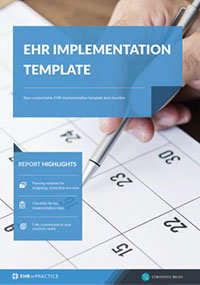Four coping strategies for unplanned EHR system downtime
Whether from a natural or man-made disaster, system failure or any variety of other reasons, healthcare practices need to be prepared for the unexpected EHR system downtime. This event can bring risk to the unprepared medical practice, which is why an unplanned downtime plan is essential to every practice.
Effective contingency planning includes drawing up processes and needed actions to minimize the frequency of downtime in the first place and to handle its occurrence. The main goal of this planning is to ensure continued quality patient care, and maintaining the confidentiality and integrity of protected health information. Here are four strategies to implement when your EHR system goes down.
1. Readily accessible paper documentation
Practices should have a sufficient supply of paper documentation forms stored in each department, in the case of EHR system downtime. This way, medical care can still continue and clinicians will have a way to document what care was given. Of course, this information will need to be added to the EHR system once it is up and running, causing duplication of work. The practice may assign this to a specific department or clinician.
For most practices, a simple SOAP note format is sufficient, as this is a standard documentation template for many healthcare professionals. It is important to note that younger clinicians may not have experience with paper charting if they were only trained in EMRs.
Recommended reading: don’t let EHR system downtime stand in the way of your project’s success - have a look at our EHR selection survival guide.
2. Medication safety checking
A significant risk to the medical practice is an increased risk of medication errors during the downtime. Most EHR systems have automatic medication alerts in regards to medication interaction and appropriate medication dosing. Clinicians can come to rely on these alerts when prescribing or administering medication to the patients.
In the event of EHR system downtime, clinicians must have a protocol to monitor the prescribing and administration of medication. A binder with commonly used medications should be accessible, including information about appropriate dosing and potential interactions.
3. Flexibility, professionalism, and communication
In most practices, each person in the practice has a clearly defined role and set of responsibilities. However, in the event of an EHR downtime, staff and clinicians will need to be flexible while staying professional. If staff remain calm and professional, patients will be more patient and understanding. Have processes in place for patient follow up once the system is restored. A simple phone call after discharge will likely be sufficient.
Communication is key. This helps to avoid chaos, anxiety and confusion. Consider creating a workflow or communication tree, in which one individual from each department is responsible for sharing updates with the rest of the department team. Lead administrators and clinicians should meet regularly throughout the downtime to ensure that operations and patient care are continuing.
4. Track difficulties for future preparation
If the practice is prepared for a downtime and stays calm throughout the time period, then chaos can be minimized. Troubleshoot difficulties in order to implement a strategy for future downtime. Preparation is the best strategy.
Free white paper

EHR Vendor Directory
Get the most up-to-date directory of EHR software vendors. Find the best software for your practice.

Featured white papers
-

EHR Implementation Template
Get all the planning tools you need to make your EHR implementation a success
Download -

EHR implementation: 6 steps to success
Step-by-step information on how to implement EHR effectively
Download -

EHR Vendor Directory
Get the most up-to-date directory of EHR software vendors. Find the best software for your practice.
Download
Related articles
-

EHR Implementation Plan: Your 8-Step Checklist
Your comprehensive checklist for creating an EHR implementation plan.
-

A template for your EHR project implementation timeline
Determining your EHR project timeline will prove tricky, but having some expectations of time fra...
-

5 important areas of EHR training during implementation
Successful EHR implementation is not possible without crucial EHR training

